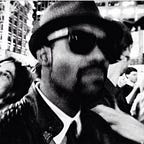2020 through the lens of Experiential Design
What the f*#k just happened!
2020 right?! January, February, Quarantine, December. It flew by, and the world changed just as fast. Our entire programming got canceled this year so we weren’t able to continue our work.
That being said, there’s much to reflect on that I’d like to share with you all.
The U-Turn of the Experience Economy
2020 pulled the rug from under the Experience Economy. Many of us were so sure that this year would be a boom for the industry with the likes of Meow Wolf and physical spaces popping up all over.
COVID-19 happened, and since March, 76% of event businesses have lost 75% of their business. 58% pivoted to new projects. Much of those projects are virtual, which had a 23% market-size increase. In other words, that’s an increase from $77B to $94B. The Experience Economy is not dead. It only made a U-turn towards virtual.
The Metaverse: What it is, Where to find it, Who will build it.
COVID-19 and the resulting lockdowns have accelerated the internet’s evolution by 5 years and made Metaverse a central focus for Big Tech in 2020. But what is it? Matthew Bell does an exceptional breakdown of what is the future of the internet.
Much of this isn’t just theory. This year, we saw the internet move towards the metaverse with Travis Scott and Fortnite, and then there’s Roblox, the gaming platform that went public to embrace its vision of the metaverse. The good in all of this is that the internet is evolving towards a more experiential landscape. At no point in time is the role of experiential design more important.
The Future of Media is now Experiential
From the dawn of the internet, we’ve contended with text, audio, and video as the media format for our content. We’ve iterated and improved them over the years giving us Netflix, YouTube, Medium, and Spotify of the world. 2020 has given us the necessity to innovate using our age-old formats to bring us more immersive and experiential platforms.
Technologists, designers, artists are all asking the same question — how do we create more connected experiences online? This has given rise to new platforms like Clubhouse, Nowhere, Topia, High Fidelity, Infinite Reality, Entourage, Promenade, Sparklverse, Go Games, and as always, art is leading the way with these new technologies. The same way we use Photoshop to design websites, these are the tools we’ll use to design worlds. People want more interactive, participatory, and engaging experiences, and even Netflix is paying attention. The silver lining in 2020 is that the world’s best creators, technologists, entrepreneurs, and artists are thinking about how to do it virtually.
The Business of Experiences
Change usually brings with it opportunities, and creators of experiential content are well-positioned to benefit from the rise of the creator economy. However, we must be business-minded and creative in our strategies. Platforms like Presence, with its business-in-a-box model, help you monetize your content in more ways than ticketing. If it’s two things Presence advocate for, it’s doing it together and having direct access to your audience (DTA); otherwise, platforms like YouTube will continue to exploit creators.
The focus isn’t only on virtual because future business models are hybrid. For instance, Art Basel OVR Miami Beach opened to VIPs on Wednesday and Thursday and to the public from Friday through Sunday. While the fair’s initial online editions were free to participate in, this one is charging dealers in the Galleries sector $6,500 a pop to present between six and 10 works. An estimated $10M in art was sold at this year’s virtual festival. The keyword here is virtual. Complex Con launched Complexland, a free 5-day virtual festival loaded with brand partnerships. It’s not just art and events; Balenciaga is bringing spatial commerce online using game engines.
Designing for Connection through Screens
2020 pushed creators to re-think their relationships with digital and how we use it to create. We all jumped on Zoom, and ‘zoom-fatigue’ became a real phenomenon, but we pressed on, figuring out the ways to improve. The creators at Co-Reality Collective pioneered innovative experiences that paved the way for Burning Man’s multiverse. Our team at Presence Studio weaved platforms to create new design models for virtual festivals with Remote Burn, Sandbox, Design Science Studio, and Burning Man. Creation Theatre’s Alice in Zoomland exemplified the role of creators as innovators in the landscape of technology.
In 2020, we learned that we could design for connection virtually. We’re not quite where we want to be as experiential designers and creators, but we now know what’s possible.
This post was originally published on EXPDSN’s Substack. EXPDSN (Experiential by Design) is a community of experiential designers in deep dialogue about the purpose of experiential design and how it can be used as a tool to shift human consciousness.
